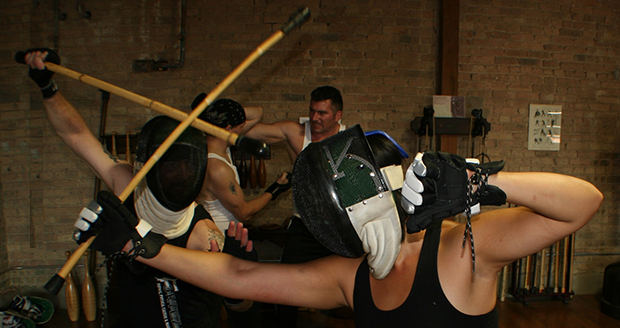- Originally published on the Bartitsu.org site on Friday, 23rd June 2017
By Tony Wolf
Recent History
The modern Bartitsu revival is now fifteen years old and, like all teenagers, it’s undergoing some significant changes.
Most of the original cadre of Bartitsu revivalists, dating back to circa 2002, were members of the Historical European Martial Arts (HEMA) movement, which coalesced out of many disparate sources including modern fencing, historical re-enactment, stage combat, Asian martial arts and various combat sports.
Communicating via the Bartitsu Forum established by author Will Thomas, they set about recreating E.W. Barton-Wright’s cross-training system in the manner of numerous other “extinct” fighting styles, from Medieval German longsword fencing to the use of the rapier and dagger, polearms, abbracciare (Italian unarmed combat), etc., which were being similarly revived at that time.
In most cases, likewise, the challenge of the reconstruction was its own justification; the object being to revive the original style, as closely as possible to the way it was originally practiced, via a combination of academic scholarship and intensive martial pressure-testing.
As such, the original Bartitsu revivalists comprised a small and relatively cohesive “fringe of a fringe” interest group, whose collaboration produced both volumes of the Bartitsu Compendium (2005/08) and established most of the characteristics of modern Bartitsu training, including the essentially “open-source” nature of the revival and the concepts of canonical and neo Bartitsu.
Individualism and diversity are inherent to Bartitsu revivalism and, therefore, attempts to “police” that revival are instantly doomed to failure. People are free to do exactly as they want to do. That understanding is why the Bartitsu Society has always been, and remains, a basically informal association of colleagues rather than a hierarchical, bureaucratic “governing body”.
In more recent years, and most especially since the explosive success of the Sherlock Holmes movies (2009/11) firmly embedded an awareness of “Victorian English martial arts” in the popular consciousness, the number of Bartitsu clubs and study groups has grown significantly and a new generation of enthusiasts has emerged.
“To create again”: recreational Bartitsu

While Bartitsu was, literally, the reality-based self-defence of its own time and place, and certainly can be undertaken purely for entertainment at pop-culture conventions and so-on, I would argue that its greatest value today is something quite different, by virtue of the many decades that have passed since its brief heyday at the turn of the 20th century. Therefore, the remainder of this essay simply advocates for a “recreational Bartitsu”.
Consider that the word “recreation” means “an activity done for enjoyment” and that it is derived from the Latin re-creare, meaning “to create again” – the latter definition being especially appropriate when applied to the activity of reviving an extinct martial art.
Although both self-defence and performance/LARP-oriented revivalisms could also be described as “recreational” in certain senses, I’m using that term to refer to a third approach; that which prioritises the notion of “art for art’s sake”. Recreational Bartitsu, therefore, is primarily geared towards recreating Barton-Wright’s original art, embracing the canonical and lineage materials as cultural artifacts of intrinsic historical value.
In other words, the primary value of the canonical material is, precisely, that it is canonical; it is our most direct link to the original cross-training system that was being developed at the Bartitsu Club circa 1901. From this perspective, modern self-defence applications are of secondary or tertiary priority, alongside demonstration of the canonical material for public display.
Further, the close and serious study of the canonical and lineage material reveals just enough of the tactical and mechanical principles behind Barton-Wright’s original system to enable practitioners to make truly educated deductions about the rest of the system. That study must include not only the Pearson’s Magazine article series, but also the panoply of supplementary sources that have been unearthed by researchers over the past fifteen years, offering crucial context to the modern revival.
Is this recreational approach any different, then, from “living history”? Does it simply result in martial arts museum pieces, beautifully preserved but lacking real utility?
No. A martial art worthy of that name must be functional, and so the aim of recreational Bartitsu is to first reassemble, and then to prove by pressure-testing, the original system on its own terms, as a method of cross-training between, specifically, c1900 boxing and kicking, the eclectic “British jiujitsu” of the Edwardian era and the Vigny style of stick fighting.
As with any martial arts reconstruction project, the aim is to get as close as possible to the original methods. Some of this reassembly is verbatim (from the canon) and some is speculative, referring to the great corpus of Bartitsu lineage materials produced by the Bartitsu Club instructors and their first generations of students, as outlined in the second volume of the Compendium.
The Japanese concept of takemusu, implying “martial creativity”, is inherent to this recreational approach. The process is collaborative and on-going. Rather than attempting to complete Barton-Wright’s abandoned work-in-progress, recreationalists are engaged in a continual state of “combat lab” experimentation.
“All-in” sparring in an identifiably “Bartitsu” style is the apex of this form of recreation. The acid test is simple – if you can fight successfully in a manner that’s closely evocative of the original method, then your recreation is good. If not, keep testing and experimenting until you can.

